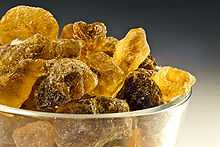Rock candy
| Rock candy | |
|---|---|
|
Colored and flavored rock candy commonly sold in the United States | |
| Alternative names | Rock sugar |
| Type | Confectionery |
| Main ingredients | Sugar, water |
| Other information | 450-225 |
|
| |


Rock candy (also called rock sugar) is a type of confectionery mineral composed of relatively large sugar crystals. This candy is formed by allowing a supersaturated solution of sugar and water to crystallize onto a surface suitable for crystal nucleation, such as a string, stick, or plain granulated sugar. Heating the water before adding the sugar allows more sugar to dissolve thus producing larger crystals. Crystals form after 6–7 days. Food coloring may be added to the mixture to produce colored candy.
Origins
Candied sugar has its origins in Iran. Arabic writers in the first half of the 9th century described the production of candy sugar, where crystals were grown as a result of cooling supersaturated sugar solutions. In order to accelerate crystallization, confectioners later learned to immerse small twigs in the solution for the crystals to grow on. The sugar solution was colored with cochineal and indigo and scented with ambergris or flower essence.
The name comes from the medieval era, and in turn lends its name to a British candy called rock.[1]
Cuisine
Rock candy is often dissolved in tea. It is an important part of the tea culture of East Frisia, where a lump of rock sugar is placed at the bottom of the cup.
In China, it is used to sweeten Chrysanthemum tea as well as Cantonese dessert soups and the liquor baijiu. In some Chinese provinces, it is used as a part of traditional Chinese medicine. It is also traditionally viewed as having medicinal properties and is prepared in food such as yao shan. In less modern times, rock sugar was affordable to only the rich.
Rock candy is widely used in India with fennel seeds as a mouth freshener, especially after meals, and is a common ingredient in Tamil cuisine, particularly in the Sri Lankan city of Jaffna.
In the Friesland province of the Netherlands, bits of rock candy are baked in the luxury white bread Fryske Sûkerbôle. In Mexico it is used in accordance with the Day of the Dead, during which time children use rock candy to create sugar skulls. In the United States, rock candy is generally unflavored and is considered an old-fashioned candy.[1]
References
External links
| Look up rock candy in Wiktionary, the free dictionary. |
| Wikimedia Commons has media related to Rock candy. |
- Exploratorium.edu Recipe for rock candy as an educational exercise in crystal and candy making.
